La Carlota, Negros Occidental
La Carlota (Hiligaynon: Dakbanwa sang La Carlota; Cebuano: Dakbayan sa La Carlota; Filipino: Lungsod ng La Carlota; Spanish: Ciudad de La Carlota), officially the City of La Carlota, is a 4th class city in the province of Negros Occidental, Philippines. According to the 2015 census, it has a population of 64,469 people [3] making it the least populous city in the province.
La Carlota Mangkas | |
|---|---|
| City of La Carlota | |
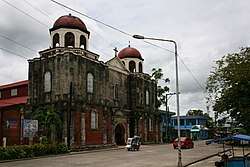 Our Lady of Peace Catholic Church | |
 Seal | |
| Nickname(s): Drumbeating City of Beauty and Dance | |
| Motto(s): Let's Go La Carlota! | |
| Anthem: Let's Go La Carlota! | |
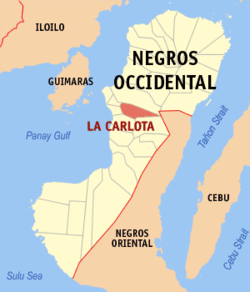 Map of Negros Occidental with La Carlota highlighted | |
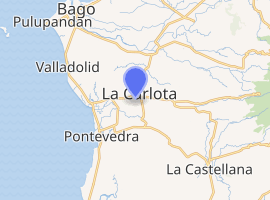
| |
.svg.png) La Carlota Location within the Philippines | |
| Coordinates: 10°25′N 122°55′E | |
| Country | |
| Region | Western Visayas (Region VI) |
| Province | Negros Occidental |
| District | 4th district of Negros Occidental |
| Founded | October 15, 1869 |
| Cityhood | June 19, 1965 |
| Barangays | 14 (see Barangays) |
| Government | |
| • Type | Sangguniang Panlungsod |
| • Mayor | Dr. Rex R. Jalando-on |
| • Vice Mayor | David Baga, Jr. |
| • Congresswoman | Atty. Juliet Marie "Yoyette" D. Ferrer |
| • Electorate | 45,191 voters (2019) |
| Area | |
| • Total | 137.29 km2 (53.01 sq mi) |
| Elevation | 31.7 m (104.0 ft) |
| Population (2015 census)[3] | |
| • Total | 64,469 |
| • Density | 470/km2 (1,200/sq mi) |
| • Households | 15,375 |
| Demonym(s) | La Carloteño Mangkasanon |
| Economy | |
| • Income class | 4th city income class |
| • Poverty incidence | 12.27% (2015)[4] |
| • Revenue (₱) | 441,635,167.48 (2016) |
| Time zone | UTC+8 (PST) |
| ZIP code | 6130 |
| PSGC | |
| IDD : area code | +63 (0)34 |
| Climate type | tropical climate |
| Native languages | Hiligaynon Tagalog |
| Website | www |
Until two years after its foundation in 1871, it was known as Simancas, a barrio under the jurisdiction of the neighboring town of San Enrique, which was led by a Spaniard who was married to a woman named Carlota. Legend has it that she was well-loved by the natives for her social works so that they named their settlement after her when it was created as a municipality near the end of the Spanish colonial era in the Philippines. In line with the Spanish practice of adding an article before a proper noun, “La Carlota” became its official name. On June 19, 1965, by virtue of Republic Act No. 4585, La Carlota was granted a city charter, becoming one of the two landlocked cities in Negros Island, the other being neighbouring Canlaon City in Negros Oriental.
In 2011, the Department of the Interior and Local Government (DILG) awarded the city with a "seal of good housekeeping" for its efforts in advancing accountability and transparency in local governance.[5] In the same year, it was also named as one of the top-performing local government units in the Philippines, ranking eighth in the component cities category. On December 29, 2011, the city was nominated for excellence in local governance, an honor given by the provincial government under its Pagpasidungog Awards .[6]
History
Throughout much of its early history, agriculture was the main source of livelihood for the native settlers of Simancas. The original inhabitants grew rice for their own consumption and latter ones cultivated tobacco for export during the Spanish colonial era. Early settlers were drawn to Candaguit River from where Simancas expanded. In 1856 historians began mentioning the village of Mampunay in their accounts of the settlement's history. The local parish priest of San Enrique at the time designated Simancas as a barrio.
Prior to the establishment of the permanent Spanish settlement in the Philippines in 1565, Simancas was led by Mangkas, a negrito warrior. He lived around the area of what is today known as Canman-ug Creek. People looked up to him for his bravery in warding off hostile forces and for keeping the peace. Legend says that because the people revered him, they named their children after him. With many inhabitants named Mangkas, the settlement eventually became known as Simancas.
The Spanish began establishing their administration over the Philippine archipelago since the late 16th century.
In 1856, the barrio of Simancas was placed under the jurisdiction of the Municipality of Valladolid. On July 23, 1864, however, the settlements of San Enrique, Pontevedra and Simancas were formed into a new municipality known as San Enrique. On October 15, 1869, the King of Spain issued a royal decree elevating Pontevedra into a parish and Simancas into a town. In 1871, King Carlos of Spain issued another royal decree changing the name of Simancas to La Carlota[7]
The decree was issued upon the request of Spanish Carlistas, or the followers of King Carlos of Spain. On December 4, 1876, a royal order was issued making La Carlota a parish.
By the 1890s, La Carlota's agricultural advances had become a model for farms throughout Negros. During this period, the sugar planters of La Carlota formed Circulo de Agricultores, the first organization on the island to undertake an anti-locust campaign. When the Philippine revolution broke out in 1898, the planters actively participated in the fight for independence from Spain.
The 1890s were important years in the history not only of La Carlota but of the whole island. It was during this decade when the levantamiento or uprising against Spain started and ended with the capitulation of the Spanish authorities in Bacolod, the capital of the province, to the revolutionary forces in 1898. The division of Negros island into two distinct provinces (Negros Occidental and Negros Oriental) took place in 1890 at the start of this historic decade. La Carlota as well saw a flowering of culture during this decade, which ushered in what many consider as its golden literary age. Near the end of that decade was born in La Carlota one of its most famous children in the literary field: Adelina Gurrea. She later gained world prominence as a journalist, poet and novelist in Spain where she espoused women's causes in her writings.[8]
From 1901 to 1906, La Carlota figured prominently in the anti-American resistance movement on Negros. It produced some of the best-known Babaylan leaders, chief among whom was Papa Isio. He led the struggle against the American occupation that replaced the Spanish regime as a result of the Treaty of Paris that ended the Spanish–American War and ceded control of the Philippines to the United States. Babaylans or entrencirados conducted guerrilla warfare against the American forces in the towns of La Carlota, Isabela, Kabankalan and La Castellana.
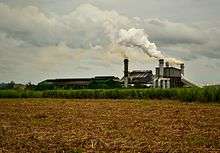
The American period saw the construction of a Gabaldon-type school building in 1908. The Central Azucarera de La Carlota,[9] considered as the biggest sugar mill tandem in Asia, was constructed by the Elizalde family in 1918.
The period from 1918 through the 1980s saw further expansion in La Carlota in terms of infrastructure. The Presidencia Building, the seat of the local government, was constructed in 1934, and since then has become a landmark in the city center. In 1948 the La Carlota City High School building was constructed. Two years later, it hosted the first-ever carnival to be held on the island. La Carlota has produced three world boxing champions: Pancho Villa, world flyweight champion from 1923 to 1925; Small Montana, world flyweight crown holder from 1935 to 1938; and Little Dado (Eleuterio Zapanta), world bantamweight champion in 1940 and world flyweight champion in 1941.
The creation of La Carlota as a chartered city occurred on June 19, 1965 by virtue of Republic Act No. 4585.[10] In 1967, La Carlota City College was established, becoming the only community college in the province at that point in time to be operated by a local government unit. From its humble beginnings as a small settlement, La Carlota has evolved into one of the major sugar-producing cities in the Philippines.
Geography
La Carlota City is geographically located at the north-central portion of Negros Occidental. It is bordered in the north by Bago City, in the east by Kanlaon Volcano and Canlaon City of Negros Oriental, in the southeast by the town of La Castellana, in the southwest by Pontevedra and in the west by San Enrique. It has a total land area of 13,729 ha (137.29 km2), most of it devoted to agriculture.
Climate
The city enjoys two distinct seasons like the rest of the Philippines: The dry season from January through May and the wet season from June through December.
| Climate data for La Carlota City, Negros Occidental | |||||||||||||
|---|---|---|---|---|---|---|---|---|---|---|---|---|---|
| Month | Jan | Feb | Mar | Apr | May | Jun | Jul | Aug | Sep | Oct | Nov | Dec | Year |
| Average high °C (°F) | 28 (82) |
29 (84) |
30 (86) |
32 (90) |
31 (88) |
30 (86) |
29 (84) |
29 (84) |
29 (84) |
29 (84) |
29 (84) |
29 (84) |
30 (85) |
| Average low °C (°F) | 23 (73) |
23 (73) |
23 (73) |
24 (75) |
25 (77) |
25 (77) |
25 (77) |
25 (77) |
25 (77) |
24 (75) |
24 (75) |
23 (73) |
24 (75) |
| Average precipitation mm (inches) | 100 (3.9) |
75 (3.0) |
90 (3.5) |
101 (4.0) |
183 (7.2) |
242 (9.5) |
215 (8.5) |
198 (7.8) |
205 (8.1) |
238 (9.4) |
194 (7.6) |
138 (5.4) |
1,979 (77.9) |
| Average rainy days | 14.9 | 11.3 | 14.5 | 17.4 | 26.4 | 28.4 | 28.5 | 27.5 | 26.9 | 28.4 | 24.2 | 17.2 | 265.6 |
| Source: Meteoblue [11] | |||||||||||||
Barangays
.jpg)
La Carlota City is politically subdivided into 14 barangays (villages), three urban and eleven rural areas. The urban barangays are Barangay I, Barangay II and Barangay III, which are all situated in the city proper. The farthest from the city is Barangay Yubo, which is 17.9 kilometers from the urban core. The city's barangays are as follows:
Demographics
The first recorded census, conducted in 1903, pegged the population at 3,097. The 1995 Philippine Statistics Authority survey recorded a population of 56,414. Two years later, the population grew to 57,982, increasing to 62,094 in 2002. By then population density was 4.5 persons per hectare. Of the 14 barangays or villages, Barangay II has the biggest population with 9,221 and Barangay Yubo has the smallest with 1,962.
About 96% of the people use a local Negrense variant of Hiligaynon as their main language of communication, while the remaining 04% of the population use Cebuano. English, and sometimes Filipino, are generally understood and spoken by a large segment of the city's population, especially amongst the well-educated peoples.
| Population census of La Carlota | ||
|---|---|---|
| Year | Pop. | ±% p.a. |
| 1903 | 13,097 | — |
| 1918 | 20,410 | +3.00% |
| 1939 | 26,084 | +1.17% |
| 1948 | 45,789 | +6.45% |
| 1960 | 56,772 | +1.81% |
| 1970 | 38,321 | −3.85% |
| 1975 | 40,984 | +1.36% |
| 1980 | 45,812 | +2.25% |
| 1990 | 56,443 | +2.11% |
| 1995 | 56,414 | −0.01% |
| 2000 | 56,408 | −0.00% |
| 2007 | 63,584 | +1.67% |
| 2010 | 63,852 | +0.15% |
| 2015 | 64,469 | +0.18% |
| Source: Philippine Statistics Authority[3][12][13][14] | ||
Landmarks
- Our Lady of Peace and Good Voyage Catholic Church
- Standing in the heart of La Carlota City on La Paz Street, Barangay I, Poblacion is this old church, built in 1876 during the Spanish era. It has the distinction as one of the very few churches of Romanesque architectural design in the region.
- A distinct quality of this church was its use of Silay red bricks and coral stones bonded together by lime mixed in duck eggs as a binder. The materials were taken from Guimaras Island. The church was built by Filipinos forced to work under the polo system during the Spanish regime. The unpopular practice required Filipino males from age 16 to 60 to render free labor constructing churches, roads, bridges and other infrastructure for a total of forty days during the year.
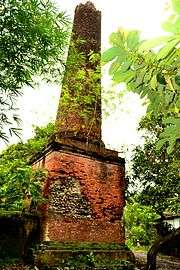
- Muscovado Sugar Mill Brick Chimney Ruins
- This muscovado sugar mill brick chimney at Hacienda Canman-ug, Barangay Batuan was constructed before the establishment of Central Azucarera de La Carlota. It was powered by an A & W Smith Company steam engine manufactured in 1883 in Glasgow. This tourist destination offers a glimpse into the lives of Mangkasanons over a century ago and serves as a vehicle of knowledge on how the sugar industry in this part of the world has evolved.
- Iron Dinosaurs of Central Azucarera de La Carlota
- Visitors entering through the western part of the city are greeted by a black vintage steam locomotive, which the locals have dubbed as the “Iron Dinosaur” of La Carlota.
- Infante Heritage House
- The lion-guarded ancestral house of the Infante family at Hacienda Guadalupe, Barangay Ayungon is located almost half a kilometer from the highway. The place is home to a number of antique religious icons, hand-painted porcelain china wares and carnival glasses. It is home to one of the oldest yet operational German-made grandfather's clock. Art deco pieces from center tables to cabinets figure in the family's collection. Turn-of-the-century appliances and wood carvings serve as dividers at the second floor. The garden, fenced with balustrade on both sides facing the house, has a miniature lighthouse that once used to be a fountain. On December 12, 2001, the house was designated by the National Historical Institute as a heritage house, and a historical marker was placed on the property.
- Presidencia Building
- The seat of the local government, constructed in 1934, is a landmark in the city center.
- La Granja Agricolas
- This agricultural model farm was established in 1881 through a Spanish royal decree issued on November 15, 1881 and was formally opened on July 8, 1884. The Philippines government maintains a stock farm in Barangay La Granja as well as a research center established by the Philippine Sugar Commission.
- Agora Public Market
- It was constructed in 1981 to replace the old public market of La Carlota that was destroyed by fire in 1978. It is named after the Greek term "Agora", which stands for a public open space used for assemblies and markets. It is located just a few meters away from the public plaza.
Festivals
- Pasalamat Festival: This is a thanksgiving celebration held on the last Sunday of April. Pasalamat brings together the La Carloteños in unity and thanksgiving to God Almighty for the gift of life and of perseverance despite life's difficulties. The festival attracts local and international tourists as merrymakers don colorful costumes fashioned out of indigenous materials dancing to the unique and original “Pasalamat Samba Beat” played by local drum beaters using percussion instruments.
- The Christmas Festival of Lights and Music: It features lighted trees in the park and lighted private and public buildings around the city. Considered the biggest of its kind in the province, it also showcases various churches and local choir groups in the nightly Christmas Cantata at the park from December 15-January 1.
Notable people
- Adelina Gurrea - Spanish Philippine poet and journalist.
- Gilbert Luis R. Centina III - Filipino-American novelist and prize-winning poet.
- Pancho Villa - World flyweight champion from 1923 to 1925.
- Small Montana - World flyweight crown holder from 1935 to 1938.
- Little Dado (Eleuterio Zapanta) - Boxer from 1938 to 1944.
Sister Cities
References
- "City". Quezon City, Philippines: Department of the Interior and Local Government. Retrieved 30 May 2013.
- "Province:". PSGC Interactive. Quezon City, Philippines: Philippine Statistics Authority. Retrieved 12 November 2016.
- Census of Population (2015). "Region VI (Western Visayas)". Total Population by Province, City, Municipality and Barangay. PSA. Retrieved 20 June 2016.
- "PSA releases the 2015 Municipal and City Level Poverty Estimates". Quezon City, Philippines. Retrieved 12 October 2019.
- "La Carlota City: 2011 DILG Awardee Seal of Good Housekeeping for Local Governance". Retrieved 2013-08-29.
- "Mayor reports city's accomplishments". Retrieved 2013-08-29.
- "Inside Negros: La Carlota City". Archived from the original on 2008-08-18. Retrieved 2013-08-29.
- "HISTORY OF LA CARLOTA CITY". Retrieved 2013-08-29.
- "Company Overview of Central Azucarera De La Carlota Inc". Retrieved 2013-08-29.
- "Province of Negros Occidental: La Carlota city". Retrieved 2013-08-29.
- "La Carlota: Average Temperatures and Rainfall". Meteoblue. Retrieved 7 May 2020.
- Census of Population and Housing (2010). "Region VI (Western Visayas)". Total Population by Province, City, Municipality and Barangay. NSO. Retrieved 29 June 2016.
- Censuses of Population (1903–2007). "Region VI (Western Visayas)". Table 1. Population Enumerated in Various Censuses by Province/Highly Urbanized City: 1903 to 2007. NSO.
- "Province of". Municipality Population Data. Local Water Utilities Administration Research Division. Retrieved 17 December 2016.
- "Carson Sister Cities Association". Retrieved 2013-08-29.
External links
| Wikivoyage has a travel guide for La Carlota, Negros Occidental. |
| Wikimedia Commons has media related to La Carlota, Negros Occidental. |